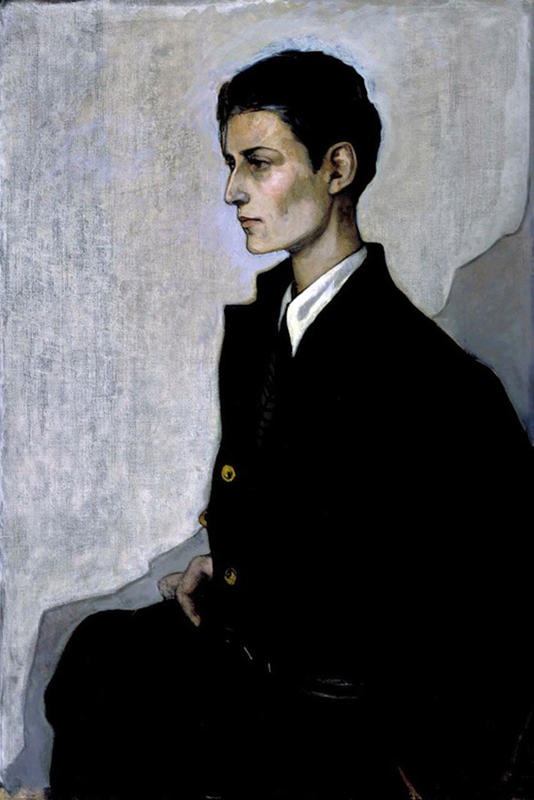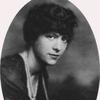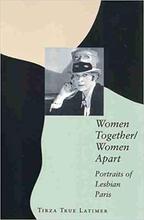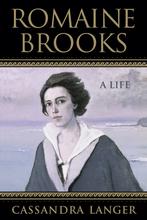More about Peter (A Young English Girl)
- All
- Info
- Shop

Contributor
Romaine Brooks knew what she was doing with gender and sexuality in this painting.
Without knowing the context of this portrait, there is no clear way of immediately gendering the subject, a person dressed undeniably on-point, but in conventionally masculine clothes for the 1920s, with no other signifiers of their situation or identity around them. The artist, Romaine Brooks, clearly capitalized on this uncertainty, titling the piece with the apparently contradictory “Peter (A Young English Girl).” The moment of confusion and ambiguity the portrait creates reflects the lives of both painter and sitter. Both Brooks and Peter, one of the aliases of the woman known as Gluck, were butch lesbian artists working and living in a community of their compatriots in Paris at the start of the twentieth century. This painting is only one example of the many portraits Brooks created that provides us with a glimpse into the controversial beginnings of a now-recognizable subculture.
Just as this portrait quietly revels in the unexpected combination of gendered signifiers, Gluck spent much of her life openly defying heterosexual, patriarchal, and even linguistic norms. She took the name “Gluck” from an abbreviation of her last name, Gluckstein, and wrote on the back of publicity prints, "Please return in good condition to Gluck, no prefix, suffix or quotes." Keeping her name prefix-less, and therefore genderless and mysterious, was very important to her—she once left an art society because she was referred to as “Miss Gluck.” At gallery openings, she shocked critics and journalists with her masculine presentation. Many of them saw her choice of short hair, suits, smoking habits, and an androgynous moniker as a deliberate hostile challenge to a society with a rigid gender binary that could only be upheld through appropriate clothing choices. Others saw it as an expression of her artistic spirit and eccentricity. Gluck’s own thoughts on the matter? She described her chosen presentation as “exciting,” and espoused the comfort and practicality of men’s clothes over women’s (something anyone who’s dealt with absurdities like the illogical sizing patterns and utter lack of functional pockets in women’s clothes today can relate to).
Gluck herself was also a painter; this piece was originally part of a collaboration between her and Brooks in which both artists created portraits of each other, although Gluck did not hold up her side of the bargain and left her painting unfinished. In addition to portraits, she created landscapes and still lifes of flowers, based on floral arrangements by one of her partners, a decorator named Constance Spry. Her love life regularly influenced her work, despite the risk in openly acknowledging gay relationships. One of her most famous paintings on the subject, Medallion (YouWe), depicts her and another lover, Nesta Obermer, who at the time was married to an American businessman, on an opera date.
When Brooks first exhibited this painting, it originally caused an outcry due to the deliberate (and then-unprecedented) way she pushed twentieth-century Western boundaries of gender. Although neither the artist nor the subject could’ve known it at the time, its publicity, and the publicity of works like it, helped contribute to the development of butchness and androgyny as a visible form of expression, a form of expression and identification that continues to this day, both in art and life for many people.
Sources
- Doan, Laura. "Passing Fashions: Reading Female Masculinities in the 1920s." Feminist Studies 24, no. 3 (1998): 663-700. doi:10.2307/3178585.
- Lampela, Laurel. "Daring to Be Different: A Look at Three Lesbian Artists." Art Education 54, no. 2 (2001): 45-51. doi:10.2307/3193946.
- "Gluck: the Lesbian Rebel of Pre-War Painting--in pictures." Guardian. Feb 8, 2017. https://www.theguardian.com/artanddesign/gallery/2017/feb/08/gluck-pain…
- Jewish Women's Archive. "Androgynous artist Gluck is born." (Viewed on June 27, 2018) https://jwa.org/thisweek/aug/13/1895/androgynous-artist-gluck-is-born.
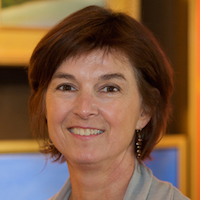
Contributor
Hannah Gluckstein was a British painter who worked under the name Gluck, but was known to her lesbian friends as Peter.
She and Brooks agreed to do portraits of each other, however she never finished her portrait of Brooks.
Wearing masculine styled clothes was fashionable at the time among middle to upper class women. Lesbians whole-heartedly embraced this new fashion trend. Peter really pushed the boundaries when she insisted on wearing trousers all the time. She wrote to her brother about her new look saying that she found it intensely exciting and intended to wear it always.

